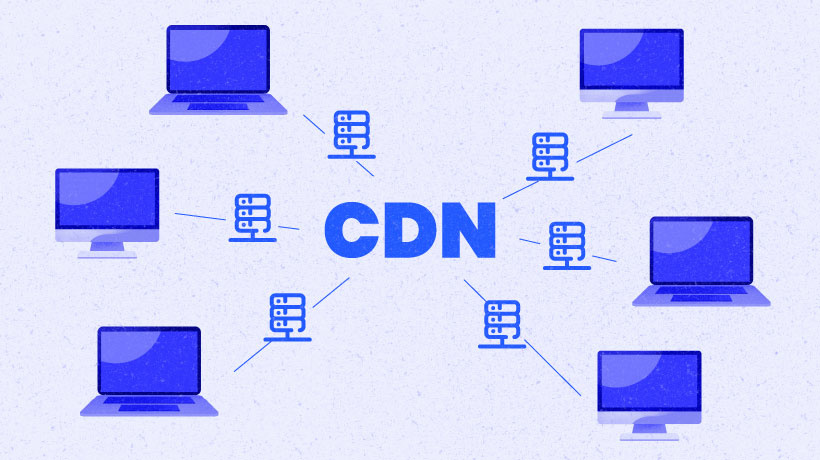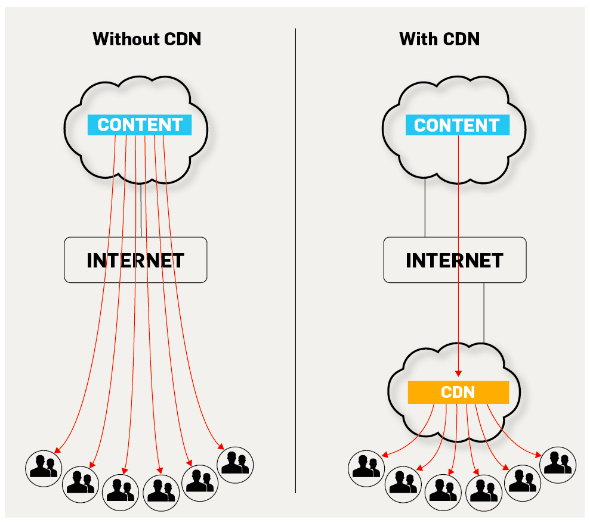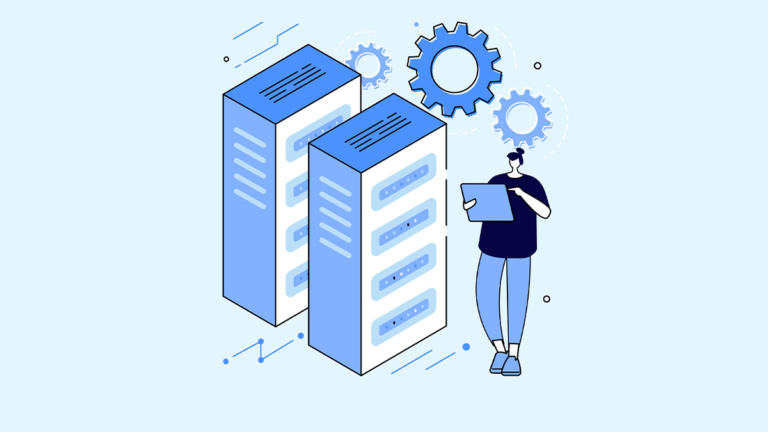How to use a CDN to improve site performance
Today’s websites and applications require high performance and loading speeds to meet the needs of users. Content Delivery Network (CDN) is a powerful tool that helps to improve website performance by providing fast content delivery to users in different parts of the world. In this article, let’s take a look at what a CDN is, how it works, and the benefits it provides.
What is a CDN
CDN (Content Delivery Network) is a global network of servers distributed across different geographical regions and designed to accelerate the delivery of content to users’ devices via the Internet. The main goal of CDN is to optimize the data transfer process by reducing latency and improving the performance of websites, applications and other online resources.
What is CDN acceleration and how does it work? A CDN caches (stores) copies of content such as images, videos, HTML pages, style files and scripts on its servers, which are hosted in different parts of the world. When a user makes a request to a website, the CDN automatically selects an edge server that is physically closer to the user and delivers cached content from that server. The speed of the CDN reduces latency and speeds up content downloads, creating a faster and more satisfying user experience.
The content delivery network also provides load reduction on the website’s source server, which is particularly useful during peak times. It also helps to increase security and can provide protection against some types of cyberattacks.
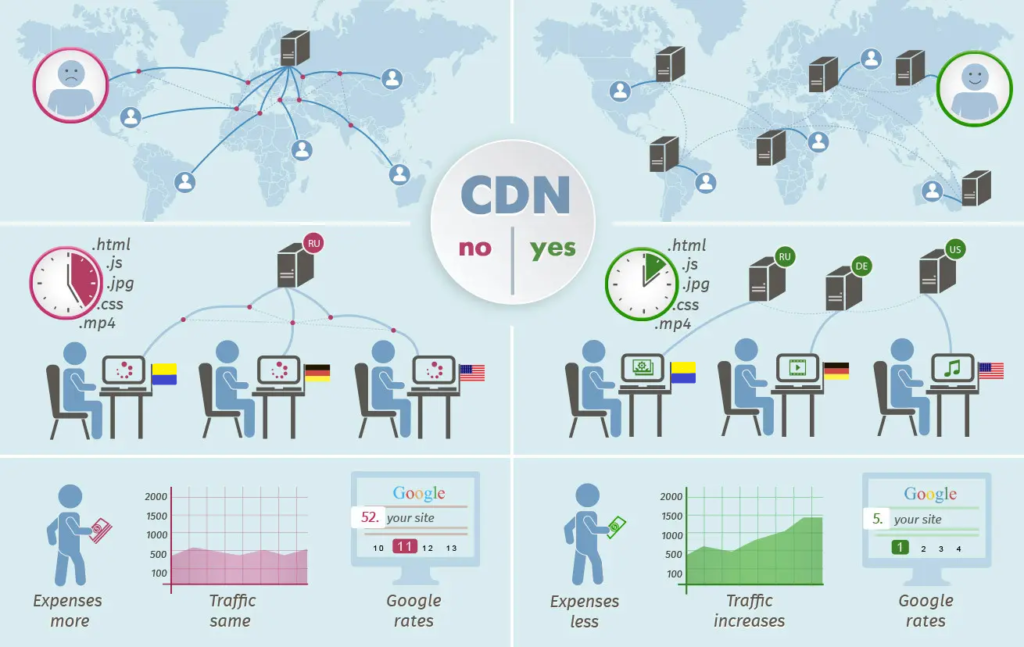
How CDN works
The operation of Content Delivery Network is based on the idea of a proximate server. When a user requests content from a website, the request is routed to the nearest server in the CDN network. This server, called a “cache server,” contains a copy of the site’s content. A CDN optimizes the delivery of content on a website or application to end users. Networking involves several key steps:
- Server allocation. With a network of regional cache servers hosting duplicated content, the user gets a faster response to their queries from the nearest edge server.
- Content Download. Source content such as images, videos, HTML files, and other resources are uploaded to servers in the content delivery network. This can happen automatically if the Content Delivery Network is configured for “pull” mode (it pulls content from the source server), or manually if configured for “push” mode (the source server owner uploads content to the CDN cache servers). The owner can also configure what data the CDN will cache.
- Selecting the nearest server. When a user enters a website URL, their request is routed to the closest CDN cache server that is physically closest to that user.
- Content caching. If the content is already on the nearest cache server and is up to date, the server delivers it directly to the user. If the content is out of date, the server requests an update from the origin server.
- Content Delivery. The cache server delivers content to the user, reducing latency and increasing page load speed. This allows users to quickly access content even if their location is far from the originating server.
- Cache Update. The CDN regularly checks the relevance of cached content and automatically updates it so that users always see up-to-date information.
In addition to improving performance, a content delivery network can also provide additional features such as DDoS protection, HTTPS support, and traffic management. CDN operation reduces the load on the source server and helps the site maintain a high level of availability even in high traffic conditions.
Push and pull zones
Push and Pull are the two main modes of content delivery network operation that determine how content is uploaded and distributed across the CDN servers.
Push Zone
In Push mode, the content provider uploads content to the CDN servers manually. This feature is most suitable for static content that rarely changes, such as images, videos, CSS files, and other files that remain unchanged for long periods of time. The owner has full control over the content that is uploaded to the cache servers, manages the uploading and updating of content, and can edit files that have already been uploaded.
Pull Zone
In Pull mode, Content Delivery Network servers automatically cache content from the source server as needed. In other words, caching only occurs when the user requests it. This zone is most suitable for dynamic content that is updated frequently (dynamically generated pages, news).
Benefits of using a CDN
Utilizing a content delivery network offers many benefits, including:
- Reducing the load on the content source;
- Reducing latency for improved user experience;
- managing traffic peaks and preventing site outages;
- cost reduction;
- increased security.
Let’s look at each of the benefits in more detail.
Reducing the load on the source
The use of Content Delivery Network helps to reduce the load on the source server of a website or application:
- A CDN distributes traffic between its servers hosted in different regions. Requests from users are handled by the nearest cache server. This reduces the number of requests directed to the source server, especially from users located in remote regions.
- Content Delivery Network stores copies of content on its servers. When content is requested, the cache server delivers it directly to the user, bypassing the origin server. This reduces the load on the source server as it handles fewer requests.
- Due to the close proximity of CDN servers, the latency time for content delivery is reduced. Users get content faster, which reduces the load on the source server.
- During peak loads, the CDN can handle a larger volume of requests, which reduces the risk of denial of service (unavailability) of the origin server. This helps to keep the site available even under high load.
- Using a content delivery network saves on bandwidth and hardware costs because some of the traffic is handled by cache servers. This can be especially useful for sites with high traffic volumes.
The CDN acts as a proxy between the source server and end users, distributing the load and improving performance. This reduces the load on the source server and provides a fast and reliable user experience.
Reduced latency for improved user experience
Content delivery latency can be significantly reduced when using Content Delivery Network:
- Uploading content from the source server to the nearest cache server reduces the time it takes to transmit data and receive a response, which reduces overall latency.
- Caching content on CDN servers eliminates the latency associated with requests to the origin server and their processing.
- CDN speeds up content delivery, the website loads faster for users, which creates a smoother interaction with the site and contributes to a better user experience.
- The content delivery network can efficiently handle high volumes of requests during peak times (promotions, events, traffic spikes), reducing latency and ensuring website availability, which contributes to a more positive user experience.
- Automatic load balancing between cache servers helps to evenly distribute traffic and prevent server overload. This also helps to reduce latency and provides a more stable website experience.
Using a CDN significantly reduces the latency of content loading, which makes the website more responsive and provides users with a comfortable and efficient experience when interacting with the website.
Managing peak loads and preventing work stoppages
Peak load management and denial of service (unavailability) prevention when using Content Delivery Network is accomplished in the following ways:
- A network of cache servers located in different geographical regions is used. When peak load occurs, user requests are balanced between different CDN servers, reducing the load on each server.
- Automatic scalability allows server resources to be activated as needed to handle additional load during peak events.
- Some requests can be processed directly from the CDN servers, bypassing the source server, which reduces the load on it, especially in the case of requests for static content that rarely changes.
- Static content can be downloaded from CDN cache servers, while dynamic content is handled by the origin server. This promotes an even distribution of the load.
- Content Delivery Network helps monitor the state of servers and traffic, provides greater flexibility in management, allows you to change settings and parameters that regulate traffic handling based on current load, and customize operation based on the needs of the site or application.
All these measures together help to handle peak loads and prevent the source server from being unavailable, which ensures that the website remains stable even under high load.
Cost reduction
Utilizing Content Delivery Network helps reduce costs for website and application owners:
- Part of the traffic is handled by CDN cache servers, which reduces the load on the source server. This saves on bandwidth.
- The need for expensive hardware and infrastructure at the source server is reduced because the CDN takes care of some of the content processing and delivery.
- Content Delivery Network handles a portion of the peak load, which reduces the cost of scaling the source server infrastructure.
- Caching and managing static content reduces requests to the source server, which improves resource utilization and reduces load.
- A content delivery network reduces traffic to the origin server, resulting in lower bandwidth and hosting costs.
- The website becomes more accessible to users even if one or more servers go down, preventing the loss of revenue associated with website unavailability.
You can save on bandwidth and hardware costs as the CDN takes care of some of the load.
Improved security
Content Delivery Network:
- Provides protection against Distributed Denial of Service (DDoS) attacks, filtering traffic and blocking malicious requests, which helps prevent source server overload and reduces the risk of website unavailability.
- Protects websites from a variety of threats, including protection against SQL injection, cross-site scripting, and other types of attacks that can jeopardize the security of a resource.
- Provides a secure connection using encryption and HTTPS protocol, protecting transmitted data and ensuring user privacy.
- Provides Web Application Firewall (WAF) functionality that filters traffic and blocks malicious requests before they reach the origin server.
- Controls access to content if it is restricted to certain users and regions.
- Monitoring and analytics tools track activity on the website and detect anomalies or suspicious behavior.
- Using a content delivery network increases site availability: even if one server becomes unavailable, other cache servers on the network will continue to serve users.
In general, a CDN provides an extra layer of security for websites or applications, helping to protect them from various threats and attacks.
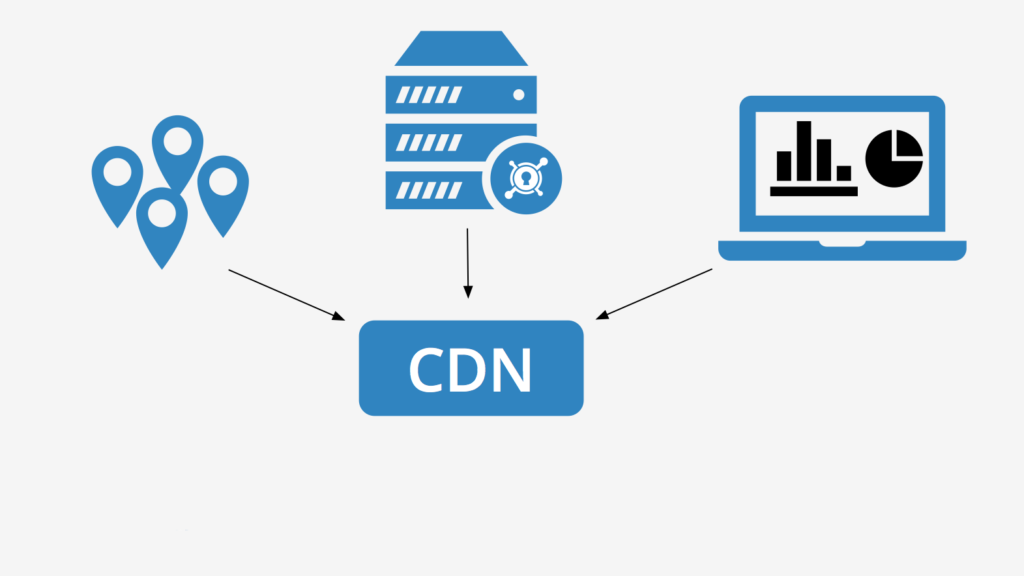
Choosing the best solution
To select the best Content Delivery Network solution, consider the following factors:
- Evaluate the nature of the content: static or dynamic, media content, dynamically generated pages, other;
- Set the expected traffic to the Web site and peak loads;
- Determine where the target audience is located to select a content delivery network with servers in close proximity;
- choose a CDN provider, study its functionality, compare prices, performance, server distribution by regions (popular CDN providers are Akamai, Cloudflare, Amazon CloudFront, Fastly);
- make sure that protection against DDoS attacks and other cyber threats, encryption and secure delivery capabilities, WAF feature are provided;
- check how easy it is to operate and customize the CDN-;
- investigate the availability and level of technical support provided by the CDN vendor in case of problems or questions;
- make sure that the CDN provides enough bandwidth for the planned load;
- Run performance tests to make sure the CDN can handle your project.
After a comprehensive analysis, you can make an informed decision and select the CDN that best meets your needs for performance, security and content availability.
Conclusions
Using Content Delivery Network is all about optimizing data transfer performance, improving website performance and providing a better user experience. It reduces source load, reduces latency, ensures availability and improves security.

